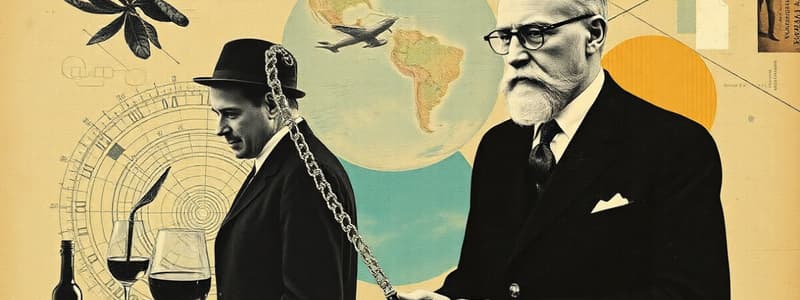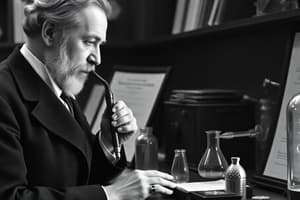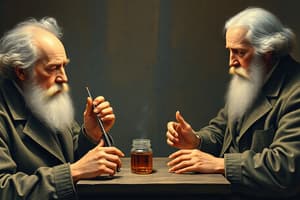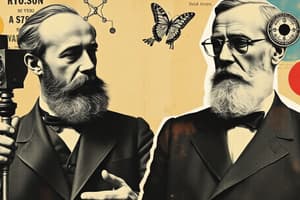Podcast
Questions and Answers
Which scientist's work significantly impacted the understanding of atomic structure by identifying a subatomic particle substantially lighter than a hydrogen atom?
Which scientist's work significantly impacted the understanding of atomic structure by identifying a subatomic particle substantially lighter than a hydrogen atom?
- Wilhelm Röntgen
- Svante Arrhenius
- J. J. Thomson (correct)
- Henri Poincaré
Whose research demonstrated a link between external stimuli and physiological responses, laying the groundwork for a specific type of conditioning?
Whose research demonstrated a link between external stimuli and physiological responses, laying the groundwork for a specific type of conditioning?
- Jules Henri Poincaré
- Kitasato Shibasaburo
- Wilhelm Röntgen
- Ivan Pavlov (correct)
Which scientist's findings regarding variations in stellar brightness have been essential for determining distances between celestial bodies?
Which scientist's findings regarding variations in stellar brightness have been essential for determining distances between celestial bodies?
- Henrietta Swan Leavitt (correct)
- Annie Jump Cannon
- Srinivasa Ramanujan
- Harriet Brooks
Who made significant contributions to the field of mathematical analysis and number theory, despite having limited formal training?
Who made significant contributions to the field of mathematical analysis and number theory, despite having limited formal training?
Which scientist is recognized for pioneering the use of statistical methods in the design and analysis of scientific experiments, significantly influencing modern research practices?
Which scientist is recognized for pioneering the use of statistical methods in the design and analysis of scientific experiments, significantly influencing modern research practices?
Which scientists conducted experiments simulating early Earth conditions which provided insights into the formation of organic molecules which has important implications for the study of the origin of life?
Which scientists conducted experiments simulating early Earth conditions which provided insights into the formation of organic molecules which has important implications for the study of the origin of life?
Who is known for developing a system for classifying stars based on their spectral characteristics, which became the foundation for a widely used stellar classification system?
Who is known for developing a system for classifying stars based on their spectral characteristics, which became the foundation for a widely used stellar classification system?
Which scientist is credited with the development of serum therapy as a preventive measure against diseases like tetanus and diphtheria?
Which scientist is credited with the development of serum therapy as a preventive measure against diseases like tetanus and diphtheria?
Whose work, while initially focused on solar system stability, inadvertently laid the groundwork for the concept of sensitivity in chaotic behavior?
Whose work, while initially focused on solar system stability, inadvertently laid the groundwork for the concept of sensitivity in chaotic behavior?
Which scientist made notable contributions to the understanding of radioactivity, including the concept of one element transforming into another through decay processes?
Which scientist made notable contributions to the understanding of radioactivity, including the concept of one element transforming into another through decay processes?
Flashcards
Wilhelm Röntgen
Wilhelm Röntgen
German physicist who discovered X-rays, revolutionizing medicine and physics.
Classical Conditioning
Classical Conditioning
Learning process identified by Ivan Pavlov where an association is formed between a stimulus and a response.
Tetanus Serum
Tetanus Serum
Serum developed by Kitasato Shibasaburo that provides immunity against tetanus.
Chaos Theory
Chaos Theory
Signup and view all the flashcards
Electron Discovery
Electron Discovery
Signup and view all the flashcards
Harvard Spectral Classification
Harvard Spectral Classification
Signup and view all the flashcards
Cepheid Variable Stars
Cepheid Variable Stars
Signup and view all the flashcards
Nuclear Decay
Nuclear Decay
Signup and view all the flashcards
Scientific Experimentation
Scientific Experimentation
Signup and view all the flashcards
Early Earth Simulation
Early Earth Simulation
Signup and view all the flashcards
Study Notes
Directory of Scientists
- Science became intimately linked with progress by the turn of the 19th century, and crucial shifts in fundamental ideas occurred throughout the 20th century.
- Discoveries abounded, and rules were rewritten in both subatomic and cosmological levels.
Wilhelm Conrad Röntgen
- German physicist Wilhelm Röntgen made important advancements in physics and medicine.
- He discovered that electrically charged vacuum tubes emitted rays that made fluorescent screens glow.
- These X-rays went through human tissue, allowing for the exposure of photographic plates but were blocked by metal and bone.
- He received the first Nobel Prize in Physics in 1901 for this discovery.
Ivan Pavlov
- Russian-born Ivan Pavlov abandoned a religious career to become a professor at the Military Medical Academy in St. Petersburg.
- He directed the physiology department at the Institute of Experimental Medicine.
- Pavlov researched the digestive sensations of dogs.
- He discovered that dogs learned to associate the sound of a bell with food, leading to salivation even without food. This conditioned response is known as classical or Pavlovian conditioning.
Kitasato Shibasaburo
- Japanese physician and bacteriologist Kitasato Shibasaburo studied in Tokyo and Berlin and developed serum therapy.
- In 1890, he discovered that injecting a serum with the antitoxin from tetanus bacteria into animals exposed to the infection conferred immunity to the animal.
- This principle was applied to protect against diphtheria.
Jules Henri Poincaré
- Mathematical physicist Henri Poincaré, born in Nancy, France, investigated the stability of the solar system.
- He showed that the initial conditions of a system can lead to considerable and unpredictable changes over time.
J.J. Thomson
- English physicist J.J. Thomson was one of the first to describe the structure of atoms.
- He identified 'corpuscles' (later called electrons) through cathode ray tube experiments.
- Electrons have a negative charge and are 2,000 times less massive than a hydrogen atom.
- Thomson's "plum pudding" model suggested that electrons are embedded in a sphere of positive charge.
Svante Arrhenius
- Arrhenius studied physics at the University of Uppsala in Sweden and became a professor of physics.
Annie Jump Cannon
- Annie Jump Cannon was a leading 20th-century authority on stellar spectra.
- She studied physics and astronomy at Wellesley College and Harvard College Observatory.
- In 1896, she was among several women selected to process astronomical data.
- Cannon pioneered the classification system of stars (Harvard Special Classification System) and classified approximately 350,000 stars.
Henrietta Swan Leavitt
- Henrietta Swan Leavitt studied astronomy at Radcliffe College.
- She studied variable stars, particularly Cepheid variables.
- Leavitt discovered a relationship between the period of Cepheid variable stars and their luminosity (brightness), important for measuring distances to other galaxies.
Harriet Brooks
- Harriet Brooks was a Canadian-born nuclear physicist.
- She studied radioactivity under Ernest Rutherford in Canada and later worked in Marie Curie's laboratory.
Srinivasa Ramanujan
- Srinivasa Ramanujan was an Indian mathematician who made major contributions to mathematical analysis and number theory, despite limited formal training.
- He was invited to Cambridge in 1911, and shared significant mathematical theorems with G. H. Hardy.
- Awarded Bachelor of Science degree in 1916 and became a Fellow of the Royal Society.
- He contracted tuberculosis and returned to India in 1919.
Ronald Fisher
- Ronald Fisher was a British statistician and geneticist.
- In 1918, he published a paper applying statistics to scientific experimentation.
Harold Urey and Stanley Miller
- In 1953, American chemists Harold Urey and Stanley Miller simulated early Earth conditions in a laboratory experiment.
- They used electrical sparks to mimic lightning and simulated a mixture of gases in the atmosphere.
- The simulation produced amino acids.
Erwin Schrödinger
- Erwin Schrödinger studied physics at the University of Vienna and later worked at the University of Zurich.
- He contributed to quantum mechanics, in particular, his famous Schrödinger equation.
Studying That Suits You
Use AI to generate personalized quizzes and flashcards to suit your learning preferences.





